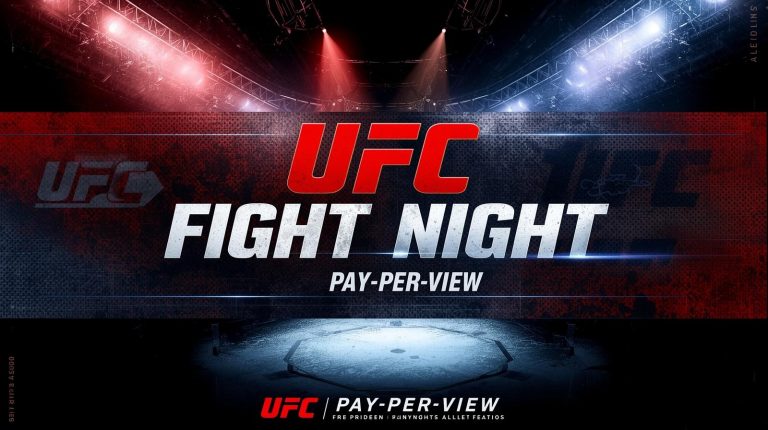If you’re new to the UFC, you’ve probably noticed two types of events on the calendar: UFC Fight Night and UFC Pay-Per-View (PPV). Both showcase top-tier mixed martial arts action, but they serve different purposes in the promotion’s schedule, structure, and business model. Understanding the difference is crucial if you’re a fan, bettor, or someone deciding how and where to watch the fights.
In this article, we’ll break down the key distinctions between UFC Fight Night and UFC Pay-Per-View events, from costs and accessibility to fight card quality, frequency, and global impact.
UFC Fight Night: The Weekly Showcase
What Is a UFC Fight Night?
UFC Fight Night events are the regular shows the UFC hosts almost every week, designed to keep fans engaged between the major pay-per-view cards. These events usually take place on Saturdays and are broadcast on ESPN, ESPN+, or UFC Fight Pass, depending on the region.
They’re often called “Fight Night” because of the branding style (e.g., UFC Fight Night: Holloway vs. The Korean Zombie). The UFC uses these cards to highlight rising prospects, contenders trying to break into title contention, and established names coming back from setbacks.
Fight Night Structure
- Main event: Typically a five-round fight, often between two ranked contenders.
- Co-main event: A strong matchup but not necessarily title-related.
- Undercard: Mix of up-and-comers, veterans, and local fighters when events are staged abroad.
Accessibility and Cost
Perhaps the biggest appeal of Fight Night events is accessibility. In most regions, Fight Night cards are included with your regular ESPN/ESPN+ subscription or with UFC Fight Pass. Unlike pay-per-view, you don’t need to spend extra money for each event.
This makes Fight Night the UFC’s entry-level viewing experience, giving fans regular content without breaking the bank.
UFC Pay-Per-View: The Premium Product
What Is a UFC PPV?
UFC Pay-Per-View events are the flagship shows of the promotion. They’re numbered sequentially — like UFC 300, UFC 320, UFC 321, and so on — and are considered the UFC’s marquee events.
PPVs feature the sport’s biggest stars, championship fights, and stacked lineups that attract both hardcore and casual fans worldwide.
PPV Structure
- Main event: Almost always a title fight or a blockbuster matchup with championship implications.
- Co-main event: Usually another high-profile fight, often another title bout or top contender clash.
- Main card: Filled with ranked fighters and household names.
- Prelims: Solid matchups that could headline a Fight Night card on their own.
Accessibility and Cost
The key difference is cost. In the U.S., UFC PPVs are sold through ESPN+ for around $79.99 per event (prices may vary). In other countries, PPVs may be included in regular TV packages or regional broadcasters, but the model remains the same: these are the premium events fans pay extra to see.
Because of the price tag, PPVs are often treated as big fight nights for groups of fans, with watch parties and large viewing audiences.
Key Differences Between UFC Fight Night and PPV
Here’s a breakdown of the major differences:
1. Frequency
- Fight Nights: Nearly every week, providing consistent action.
- PPVs: Usually once a month, around 12 per year.
2. Fight Card Quality
- Fight Nights: Strong fights, but usually fewer ranked fighters and no title bouts (with rare exceptions).
- PPVs: Stacked from top to bottom, with multiple title fights and star power.
3. Cost
- Fight Nights: Included with ESPN/ESPN+ or UFC Fight Pass subscription.
- PPVs: Separate purchase, typically $79.99 in the U.S.
4. Main Event Length
- Fight Nights: One five-round fight (main event).
- PPVs: Multiple five-round fights if there are title bouts or main/co-main attractions.
5. Global Attention
- Fight Nights: Cater mainly to dedicated fans and regional markets.
- PPVs: Global spectacles that trend on social media and attract massive betting handle.
Why the UFC Uses Both Event Types
The UFC strategically uses Fight Night and PPV events to balance its business model:
- Fight Nights keep fans engaged weekly, allow prospects to develop, and give international markets live events.
- PPVs generate huge revenue, elevate champions, and create “big fight” moments that define eras.
For example, a prospect like Umar Nurmagomedov may headline a Fight Night to build his name. But once he reaches title contention, his fights will likely move to a PPV card.
Betting on Fight Night vs. PPV
From a betting perspective, the difference is also significant:
- Fight Night events often feature closer odds, with lesser-known fighters where sharp bettors can find value. The betting handle is smaller but opportunities for profit can be higher if you do your research.
- PPV events attract massive betting volume, especially on title fights. Odds tend to be sharper due to increased public money, but the sheer number of fights on the card provides more options for prop bets, parlays, and live betting.
For bettors, Fight Nights are great for spotting emerging talent, while PPVs are where you see lines move fast based on hype and star power.
Which One Should You Watch?
If you’re a casual fan, PPVs are where you’ll see the best of the best. They’re perfect for fight parties and big sporting nights.
If you’re a hardcore fan or bettor, Fight Nights are invaluable. They let you track prospects, test betting strategies, and stay connected with the sport weekly without spending extra money.
The truth? The best UFC experience comes from following both. Fight Nights give you consistent action, while PPVs deliver the big fight feel.
FAQ: UFC Fight Night vs. UFC PPV
Is UFC Fight Night free?
Not completely free, but much cheaper. Fight Night cards are usually included with an ESPN+/UFC Fight Pass subscription. You don’t have to pay extra for each event like you do with PPVs.
Do UFC Fight Night wins count the same as PPV wins?
Yes. A win on a Fight Night card counts toward a fighter’s official record and rankings, just like a PPV win. The only difference is visibility and audience size.
Can UFC titles be defended on Fight Night cards?
Rarely. Most title fights are reserved for PPV cards. However, in special circumstances (e.g., COVID-19 era or international events), a championship fight has occasionally headlined a Fight Night.
Which is better for betting — Fight Night or PPV?
Both have advantages. Fight Nights often provide value betting opportunities with lesser-known fighters, while PPVs offer a wider selection of fights and high-profile matchups for betting.
How many UFC PPVs are there each year?
The UFC typically holds 12 PPVs per year, about one per month.
Why does the UFC have so many Fight Night cards?
Fight Nights keep the schedule packed, showcase new talent, and serve regional markets — helping the UFC grow globally without overloading fans with expensive PPVs.
Final Thoughts
The difference between UFC Fight Night and UFC Pay-Per-View ultimately comes down to scale, star power, and cost. Fight Nights are the UFC’s regular programming — consistent, affordable, and essential for building the next generation of stars. Pay-Per-Views are the crown jewels — loaded with championship fights and marketed as can’t-miss events.
For fans and bettors alike, knowing the distinction helps you decide when to tune in, when to spend money, and how to make the most out of the UFC schedule.
So the next time you see a Fight Night announced, think of it as a chance to discover tomorrow’s contenders. And when a PPV rolls around, get ready for the biggest names, brightest lights, and the moments that make UFC history.


